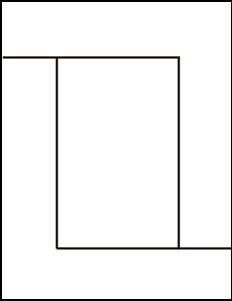Design Your Own Nature Quilt – Part One (Online)
Supply List
– 2 L-shaped cardboard frames. Create them, by cutting a file folder, like the diagram below. 2” (5 cm) is about right for the width of each side.

– Clear plastic page protector (1 or 2)
– Dry erase marker, or regular felt tip marker (water soluble)
– 3-4 different colors of construction/craft paper, one page of each.
– 2 copyright free nature photos, ~ 8 x 10, in color. (These should be printed out, not just available on your computer.) Recommended, but optional: black and white versions of the same photos. (See notes* and **)
– Paper scissors
– Glue stick
– Sketch book, or a few loose papers (no lines)
– Pencil with eraser
* We’re working with nature photos because they’re easiest to interpret in fabric. Good subjects include mountain vistas, landscapes, and vegetation. But your photos should not include people, vehicles, or structures. You may include animals, but they’ll be more challenging. Try to find graphic images with clearly defined shapes, (example: mountains,) as opposed to ones where the colors flow together, (example: sunset.) Also, make sure your photo has enough variety to keep things interesting. (Row after row of sand dunes might not cut it.)
** If you choose to include black and white photos, they should actually include a wide variety of grays. Therefore, DO NOT copy a color photo on a black and white copier. It will give you a picture with only black and white – no gray. Instead, copy it on a color copier, using the black and white setting. Or manipulate it in your computer, removing all color for a grayscale print.
Remember: You don’t need artistic skills for this class, but artistic courage is required!
Design Your Own Nature Quilt – Part Two (Online)
Supply List
(Continuing into Part Two is optional)
– Photos and sketches from Part One
– Fabrics to match photo colors. Be sure to include all the very darks and very lights seen in your photo. (You’ll need a small amount of a wide variety of fabrics.)
– Matching threads
– Muslin, at least 18” x 22” (46 cm x 56 cm.) (Don’t cut it just yet.)
– Batting and backing fabrics
– Sharp fabric scissors
– Straight pins
– Sewing machine, and basic sewing supplies
– Highly recommended, but not required: a darning foot (for free motion sewing,) or a walking foot.
– Optional: washout fabric pencils or chalk
